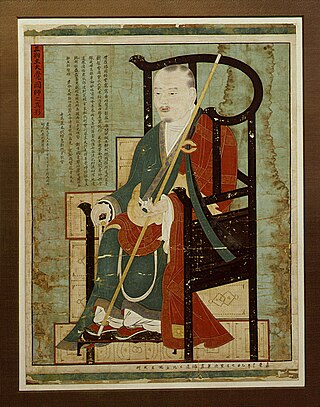Related Research Articles

Kumārajīva was a Buddhist monk, scholar, missionary and translator from the Kingdom of Kucha. He first studied teachings of the Sarvastivadin schools, later studied under Buddhasvāmin, and finally became an adherent of Mahayana Buddhism, studying the Mādhyamaka doctrine of Nāgārjuna.

Dajian Huineng (traditional Chinese: 大鑒惠能; pinyin: Dàjiàn Huìnéng; Wade–Giles: Ta4-chien4; Japanese: Daikan Enō; Korean: Hyeneung); (February 27, 638 – August 28, 713), also commonly known as the Sixth Patriarch or Sixth Ancestor of Chan (traditional Chinese: 禪宗六祖), is a semi-legendary but central figure in the early history of Chinese Chan Buddhism. According to tradition he was an uneducated layman who suddenly attained awakening upon hearing the Diamond Sutra. Despite his lack of formal training, he demonstrated his understanding to the fifth patriarch, Daman Hongren, who then supposedly chose Huineng as his true successor instead of his publicly known selection of Yuquan Shenxiu.

The Lotus Sūtra is one of the most popular and influential Mahayana sutras, and the basis on which the Tiantai, Tendai, Cheontae, and Nichiren schools of Buddhism were established.
Kenshō (見性) is a Japanese term from the Zen tradition. Ken means "seeing", shō means "nature, essence". It is usually translated as "seeing one's (true) nature", that is, the Buddha-nature or nature of mind.

The Diamond Sūtra is a Mahāyāna (Buddhist) sūtra from the Prajñāpāramitā sutras or 'Perfection of Wisdom' genre. Translated into a variety of languages over a broad geographic range, the Diamond Sūtra is one of the most influential Mahayana sutras in East Asia, and it is particularly prominent within the Chan tradition, along with the Heart Sutra.

East Asian Madhyamaka refers to the Buddhist tradition in East Asia which represents the Indian Madhyamaka (Chung-kuan) system of thought. In Chinese Buddhism, these are often referred to as the Sānlùn school, also known as the "emptiness school", although they may not have been an independent sect. The three principal texts of the school are the Middle Treatise, the Twelve Gate Treatise, and the Hundred Treatise. They were first transmitted to China during the early 5th century by the Buddhist monk Kumārajīva (344−413) in the Eastern Jin Dynasty. The school and its texts were later transmitted to Korea and Japan. The leading thinkers of this tradition are Kumārajīva's disciple Sēngzhào, and the later Jízàng. Their major doctrines include emptiness (k'ung), the middle way (chung-tao), the twofold truth (erh-t'i) and "the refutation of erroneous views as the illumination of right views" (p'o-hsieh-hsien-cheng).

Nāgasena was a Sarvastivadan Buddhist sage born in Kashmir and lived around 150 BCE. His answers to questions about Buddhism posed by Menander I, the Indo-Greek king of northwestern India, are recorded in the Milinda Pañha and the Sanskrit Nāgasenabhiksusūtra.

Awakening of Faith in the Mahāyāna is a text of Mahayana Buddhism. Though attributed to the Indian master Aśvaghoṣa, no Sanskrit version of it exists and it is now widely regarded by scholars as a Chinese composition.

Uicheon was a Korean Buddhist monk who founded the Cheontae school of Buddhism. He was the son of King Munjong of Goryeo. He lived at Ryongtongsa in Kaesong for much of his life and was buried there, where his tomb can be found today.

Daosheng, or Zhu Daosheng, was an eminent Six Dynasties era Chinese Buddhist scholar. He is known for advocating the concepts of sudden enlightenment and the universality of the Buddha nature.

Hongzhi Zhengjue, also sometimes called Tiantong Zhengjue (1091–1157), was an important Chinese Chan Buddhist monk who authored or compiled several influential texts. Hongzhi's conception of silent illumination is of particular importance to the Chinese Caodong Chan and Japanese Sōtō Zen schools. Hongzhi was also the author of the Book of Equanimity, an important collection of kōans
The term subitism points to sudden awakening, the idea that insight into Buddha-nature, or the nature of mind, is "sudden," c.q. "in one glance," "uncovered all together," or "together, completely, simultaneously," in contrast to "successively or being uncovered one after the other." It may be posited as opposite to gradualism, the original Buddhist approach which says that following the dharma can be achieved only step by step, through an arduous practice.
The Tattvasiddhi-Śāstra, is an Indian Abhidharma Buddhist text by a figure known as Harivarman (250-350).
Sadāparibhūta Bodhisattva, Never Disparaging Bodhisattva, appears in Lotus Sutra Chapter 20 which describes the practices of Bodhisattva Never Disparaging, who lived in the Middle Period of the Law of the Buddha Awesome Sound King. He persevered in the face of persecution for the sake of the correct teaching, and finally attained Buddhahood. Bodhisattva Never Disparaging was Shakyamuni Buddha in one of his past lifetimes.

Zen is a school of Mahayana Buddhism that originated in China during the Tang dynasty, known as the Chan School, and later developed into various schools. The Chan School was strongly influenced by Taoist philosophy, especially Neo-Daoist thought, and developed as a distinct school of Chinese Buddhism. From China, Chán spread south to Vietnam and became Vietnamese Thiền, northeast to Korea to become Seon Buddhism, and east to Japan, becoming Japanese Zen.

Chan, from Sanskrit dhyāna, is a Chinese school of Mahāyāna Buddhism. It developed in China from the 6th century CE onwards, becoming dominant during the Tang and Song dynasties. After the Yuan dynasty, Chan more or less fused with Pure Land Buddhism.
Zen has a rich doctrinal background, despite the traditional Zen narrative which states that it is a "special transmission outside scriptures" which "did not stand upon words."
Robert Evans Buswell Jr. is an American academic, author and scholar of Korean Buddhism and Chinese Buddhism as well as Korean religions in general. He is Professor of Buddhist Studies at the University of California, Los Angeles and founding director of the Academy of Buddhist Studies at Dongguk University, Korea's main Buddhist university.

The Dà zhìdù lùn, is a massive Mahāyāna Buddhist treatise and commentary on the Pañcaviṃśatisāhasrikā Prajñāpāramitā Sūtra. The title has been reconstructed into Sanskrit as *Mahāprajñāpāramitopadeśa. It is an encyclopedic compendium or summa of Mahayana Buddhist doctrine.

The Śataśāstra is the reconstructed Sanskrit title of a Buddhist treatise in the Mādhyamaka tradition known only in its Chinese translation under the title Bai lun. Both names translate to the Hundred Verse Treatise, although the word "verse" is implied and not actually present in either Sanskrit or Chinese. It is attributed to Āryadeva, a student of Nāgārjuna. The text was translated into Chinese by Kumārajīva in 404 CE and came to be counted as one of the three foundational texts of the Three Treatise School. In the Chinese tradition, another text by Āryadeva called the Catuḥśataka—which was not translated into Chinese for another two and a half centuries, but is extant today in Sanskrit and Tibetan—was understood to be an expanded version of the Bai lun. However, scholars today have instead interpreted the Bai lun to be a summary the Catuḥśataka. Nonetheless, the sequence in which the topics are discussed differs, as do the specifics, and also the Bai lun has some content not seen in the Catuḥśataka at all. This has led to an alternative hypothesis that it may simply represent Kumārajīva's understanding of the Catuḥśataka.
References
- ↑ Kumar, Yukteshwar (2005), A History of Sino-Indian Relations: 1st Century A.D. to 7th Century A.D, APH Pub., p.111
- ↑ Kumar (2005), p.111
- ↑ Lai, Whalen (1991). "Tao Sheng's Theory of Sudden Enlightenment Re-examined". In Peter N. Gregory. Sudden and Gradual. Approaches to Enlightenment in Chinese Thought. Delhi: Motilal Banarsidass Publishers Private Limited. p. 180
- ↑ Buswell, Robert Jr; Lopez, Donald S. Jr., eds. (2013). Princeton Dictionary of Buddhism. Princeton, NJ: Princeton University Press. p. 453. ISBN 9780691157863.